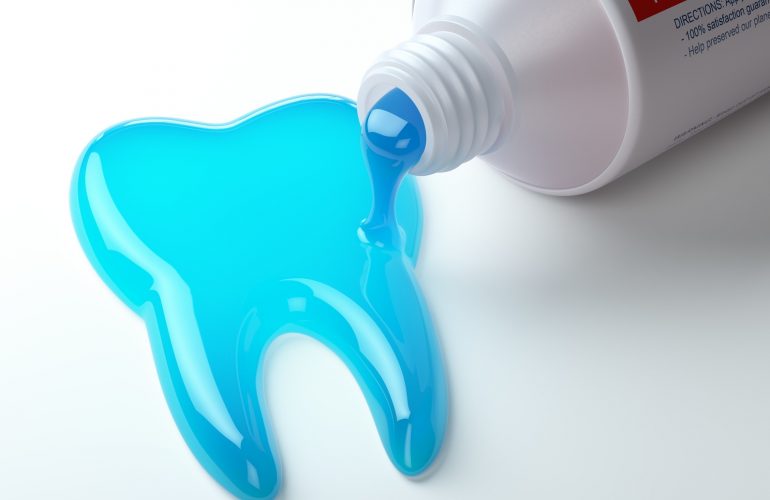In addition to restricting sugar intake and thoroughly removing plaque, fluoridation is one of the most important methods of caries prophylaxis. Fluorides, commonly used in dentistry as sodium fluoride, potassium fluoride, stannous fluoride or amine fluoride, are the salts of hydrofluoric acid, also known as fluorides. In nature, fluorides usually occur in the form of many minerals that accumulate mainly in the water.
Fluorides for the prevention of tooth decay
In the 1930s, it was discovered by accident by American water chemists that fluoride also protects our teeth from decay. They found a connection between a high natural fluoride content of the drinking water in a region and a concomitant lower caries infestation of the population living there. Based on this, scientific studies with fluoride-enriched drinking water in the USA showed that even a fluoride concentration of 0.8 to 1 milligram per liter of water causes an optimal inhibition of caries.
Fluorides inhibit the metabolism of caries bacteria, which thereby producing less acid that attacks the enamel. Furthermore, fluorides are deposited in the tooth structure and increase the resistance of the enamel to attacking acids. Thus fluorides are one of the most effective ways to prevent tooth decay, in addition to proper dental care and healthy nutrition.
In the United States, about 120 million people have been drinking artificially fluoridated drinking water since 1945. In Germany, fortification of drinking water with fluoride is permitted under food law, but prohibited under water law. Therefore, other forms of uptake for caries prevention with fluorides must be done.
Which possibilities of fluoridation are there?
- tablets,
- mouthwashes,
- toothpastes and special fluoride gels
Since 1991, fluoridated table salt has been available in Germany. Teeth can be fluoridated externally (ie with toothpaste or mouthwash) or internally (using tablets or the above-mentioned table salt).

Fluoride tablets
Fluoridation based on tablets is especially useful for children and 2 years, because consistently used fluoride tablets can significantly inhibit the formation of cavities. Since the teeth of small children in many cases are affected by the so-called baby bottle caries, additional internal fluoridation is helpful. Usually the pediatrician does not recommend pure fluoride tablets, but a combination of fluoride and vitamin D.
For small children, the tablets should be provided crushed on a spoon and not dissolved in the bottle, as they often do not decompose properly and sometimes get stuck to the bottom of the feeding bottle. If the child is already old enough, it should be the best to suck the tablet, making better use of the local efficacy of fluoride tablets.
Fluoride-containing mouthwash
Fluoride-based mouthwash typically contains between 0.025 and 0.2 percent fluoride, depending on the product. They can be used daily, preferably after brushing your teeth.
Mouthwashes are not recommended for children, as they may easily swallow when gargling. For maximum protection, you should move the mouthwash around in the mouth for about 3 minutes.
It has been scientifically proven that daily gargling with a 0.05% sodium fluoride solution can reduce caries by up to 50%.

Fluoridated Toothpaste
Fluoride toothpastes are commonplace today and are therefore the most important fluoridation source for humans. The maximum permissible fluoride concentration is 0.15%, ie 1.5 mg per gram of toothpaste. For children up to school age, the use of a toothpaste with a maximum fluoride concentration of 0.05%, ie 0.5 mg per gram of toothpaste is recommended.
Already the first baby teeth should be cleaned at least once per day with a pea-sized amount of fluoridated toothpaste. From the second year of age, the teeth should then be cleaned at least twice a day. The caries-preventive effect of the fluoride, however, can only develop if the toothpaste can act on the teeth for about 3 to 5 minutes. Therefore, you should brush your teeth accordingly.
Fluoride Gel
Fluoridated gels, in contrast to toothpaste, have a significantly higher fluoride content. They are offered in concentrations of 0.4 to 1.25% and are therefore far more effective for caries protection. However, fluoride gels should only be used after school age, and then only once a week. With regular use, the caries reduction is between 20 and 40%.
Fluoridated Salt
Whereas in Switzerland, saline has been essential for caries prophylaxis since the 1950s, fluoridated saline has only been available in Germany since 1991. Per kilogram it contains 250 mg fluoride. The daily consumption of about 4 g of this salt leads to an intake of about 1 mg fluoride.
While salt fluoridation is a very simple method, its effectiveness depends greatly on how often fluoridated salt is used in the preparation of food. It should not be forgotten that most of the daily salt intake comes not from self-cooked meals, but from pre-salted products such as bread or sausage. However, if it can be ensured that 4g fluoridated table salt is consumed per person per day, this type of fluoridation is absolutely equivalent to the others.
Weitere Beiträge

Dental Supplemental Insurance
Good dentures are expensive. Health insurers usually pay only a small portion of the cost. The insured person must pay for the rest - and these are often high amounts. With supplementary dental insurance, patients can protect themselves against high costs for high-quality dentures.

Dental anxiety
In Germany alone, one in five people are afraid of visiting the dentist, and not just of major surgery. Before each appointment, this uncomfortable feeling spreads, sometimes severely and with significant side effects. Where this fear comes from, what helps and what you can do about it, we have collected for you.


